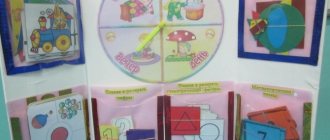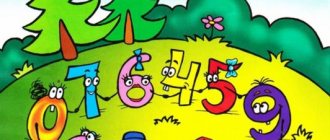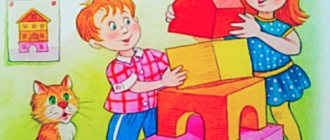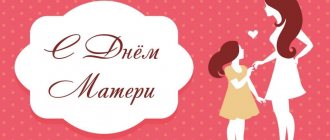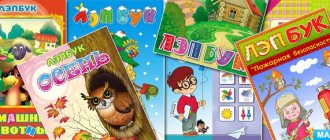Lapbook. Lapbooks on all topics - Lapbook “World of Insects” for children 4–5 years old
Publication “Lapbook “World of Insects” for children 4–5...”
Lapbook business card 1. Lapbook cognitive development “The World of Insects” 2. Authors: 3. For children 4-5 years old. 4. Goal: to expand children’s understanding of insects, their development, structure and types. Develop speech. Memory, thinking. 5. A laptop is a book format...
Lapbook “Fun Math” for primary preschool age
The “Fun Mathematics” laptop helps children of primary preschool age to form logical and mathematical concepts, increase the activation of thought processes, and develop sensory ways of cognition. The “Fun Math” laptop is intended for additional, group…
Ecological lapbook “Eco-preschool children” for the middle group
[Goal: To convey to children the idea that they need to take care of nature. Objectives: To give children an initial understanding of ecology; Develop cognitive interest; Expand children's knowledge; Strengthen children's knowledge about animals, plants, trees; Cultivate respectful and...
Lapbook “My Family” for children of primary preschool age
Lapbook “My Family” Lapbook is a folding folder designed for children of primary preschool age. The contents of this folder can be changed and supplemented according to age and needs. The purpose of the manual is to introduce spiritual and moral values, family traditions and...
Middle group. Junior preschool age. Children 4 - 5 years old
Lapbook “Fun Math” for primary preschool age
MUNICIPAL BUDGETARY PRESCHOOL EDUCATIONAL INSTITUTION "KINDERGARTEN No. 38 "LEVUSHKA"
G. BELOVO
Lapbook “Fun Mathematics”
for primary preschool age. Prepared by teacher Galushchenko E.S. Goal: for children to master mathematical ways of knowing using educational...
Lapbook “Birds” in the middle group
Goal: to clarify and expand children’s ideas about birds. Children’s ability to find signs of similarities and differences in the appearance of birds. Objectives: 1. to form children’s ideas about the diversity of birds, knowledge about the general features of the appearance of birds (beak, wings, feather cover, ...
Lepbook and its importance in working with preschool children"consultation
MDOU "Kindergarten No. 109"
Experience on the topic
“Leapbook and its importance in working with preschool children”
2018
1. Dear colleagues, I would like to share with you my experience of working with Lapbooks and talk about its importance in working with preschool children.”
2. In our practice, we increasingly encounter children who are not interested in what is happening in the joint educational activities of the teacher and children. Therefore, an important condition for increasing the effectiveness of work with preschool children is not the expansion of educational tasks, but the use of modern pedagogical technologies, related, first of all, to the specifics of the child’s communication with adults and peers with the effective organization of the child’s life in kindergarten, aimed at developing the child’s independent activity and for personal development.
One such tool is the Lapbook.
3. A lapbook is a universal guide that can be the result of children’s project-based and independent activities, a thematic week provided for by the main educational program of a preschool educational institution. Can be used in the implementation of any of the educational areas, ensuring their integration. By combining teaching and upbringing into a holistic educational process, a lapbook allows the teacher to build activities based on the individual characteristics of each child, to create conditions under which the child himself becomes active in choosing the content of his education.
The use of a lapbook ensures equality of opportunity and the full development of every child, regardless of place of residence, gender, nationality, language, social status, including for children with special educational needs.
4. Lapbooks were first created in America. Lapbook - literally translated from English means
“knee book” (lap – knees, book – book).
5. The author of the adapted laptop technology in our country is Tatyana Pirozhenko, who gives the following definition of this term
6. “This is a homemade paper book with pockets, doors, windows, and movable parts that a child can take out, rearrange, and fold at his own discretion. It collects material on a specific topic. At the same time, a lapbook is not just a craft. This is the final stage of independent research work that the child has done while studying this topic.
What is considered the highest stage of development of children’s cognitive activity?
7.Today, the state has set the task of preparing a completely new generation: active, inquisitive.
A modern child needs not so much to know a lot, but to think consistently and convincingly, and to show mental effort.
A lapbook is a great way to both study and reinforce a certain topic with children, comprehend the contents of the book, and conduct research work, during which the child participates in searching, analyzing and sorting information.
8. When organizing the educational process in a group, we were faced with the problem of interaction between a child and a peer: the children did not know how to engage in joint activities: accept a common task, distribute actions among themselves, and show interest in the actions of their partner. All this led to conflicts, disunity, and inability to complete things.
9. A laptop is not just a method that helps consolidate and practice acquired knowledge, it is a flight of fantasy that can give unpredictable results, it is research that, once started, will continue throughout life, because if you sow the “seed” of discovery and research in a child, it will grow and increase. The teacher’s task is only to give students confidence in their abilities and properly motivate them to open new horizons.
10. The laptop meets all the requirements of the Federal State Educational Standard and is well suited for organizing direct educational activities for preschoolers in groups where children of different ages are studying at the same time.
Working with a laptop contributes to the main areas of partnership between an adult and children:
- involvement of the teacher on an equal basis with the children,
- voluntary participation of children in activities,
- free communication and movement of children during activities,
- open time end of activity (everyone works at their own pace).
Making a manual such as a lapbook
ensures the implementation of partnerships between adults and children;
promotes creative self-realization of the teacher.
unites not only children and parents, but also teachers.
This is evidenced by the following slides, which present the work of our colleagues Ilina Olesya Leonidovna and Grishchenko Ekaterina Sergeevna
11. Each lapbook is unique, as is its creator, there is no right or wrong method for creating it, because everything depends on how the child perceives a given topic, what means he uses to achieve his goals.
12. During the day, children can take any information from the lapbook pockets. The colorful design of didactic tasks, mini-books, and various games attracts children, and they immerse themselves in creativity and learning something new. Thus, the information presented in the lapbook performs a cognitive and developmental function.
13. The results of observing the pedagogical process showed that children began to actively interact with peers and adults and show interest in participating in joint activities.
14Cognitive interest, curiosity, independence and initiative in solving assigned problems have increased significantly. The material being studied is successfully used by children in everyday life.
15. Thus, we see that the Lapbook method is relevant and very effective. Using this method, the child’s subjective position is formed, his individuality is revealed, interests and needs are realized, which in turn contributes to the child’s personal development. This corresponds to the social order at the present stage.
Thank you for your attention. hand out a brochure
Psychological mirror
In early preschool age, it is enough to form and expand children’s ideas about three basic emotions: joy, sadness, anger. I suggest making a Lapbook for this age. The basis can be taken from any of the proposed (What could be the basis) Games and exercises with the “Emotions” lapbook.
“Find the same emotions” (Sheet 4 and 5)
Goal: learn to compare emotions in pictures, find the same emotion, and name it. The circles are cut out, and “curtains” are placed on top. They should be located next to the cut out parts. Attach to the base so that the inside rotates.
“Cut pictures” (Sheet 2, 3, 7)
Goal: development of integrity of perception, recreating imagination. The set has 3 levels of complexity (2 parts, 3 parts, 4 parts). Cut the cards and place them in beehive pockets according to emotions.
“Bees and daisies”
Goal: learn to compare emotions in pictures, find the same emotion, and name it. The child needs to put a bee on a flower with the same emotion.
“Houses for bees.”
Goal: development of children’s perception, learning to compare the shape of an object. Return the bees to their houses, leaning on the shadow.
“Clouds”
Goal: learn to compare color with emotions. Children need to water the cloud with a color that matches the mood of the flower.
“Continue the row” (Sheet 8, 9, 10)
Goal: development of attention and thinking. You need to determine what emotion will come next.
“Remember and repeat”
Goal: development of visual and auditory memory. Remember and repeat a row of unfolding accordions or laid out independently from cut parts of sheet 8. To develop auditory memory, a row is dictated, the child picks it out after the entire row has been named. It's better to start with two or three objects. By the age of 4, these rows can reach 5 objects.
“Rain”
Goal: teaching the relationship between color and emotion, developing emotional perception. You need to water the daisies from a cloud of the corresponding color to the emotion.
“Big, medium, small”
Goal: development of size perception.
Daisies in three sizes. You can glue the medium-sized ones onto the background and lay out only the small, large ones, or you can sort all three sizes.
Assembly option No. 2.
Lapbook, instructions on how to assemble, buy, emotions, templates, download, free, junior group Lapbook, instructions on how to assemble, buy, emotions, templates, download, free, junior group Lapbook, instructions on how to assemble, buy, emotions, templates , download, free, junior group Lapbook, instructions, how to assemble, buy, emotions, templates, download, free, junior group
Lapbook materials
Lapbook, pocket, download, free, emotions Lapbook, pocket, download, free, emotions Lapbook, pocket, download, free, emotions Lapbook, pocket, download, free, emotions
Backgrounds and frames
We kindly ask you to write reviews when downloading! To download, right-click on the image and save. Or download the archive immediately: lapbook Emotions
Instructions for assembling Lapbooks on Emotions: download for free Instructions for assembling Lapbooks on Emotions on the website
Also on the site there is a Lapbook “Emotions” for children of the middle group, a Lapbook “Emotions” for children of senior preschool age, “The World of Emotions” for children of the preparatory group. More details
Lapbooks on other topics.
Views 1,513, Today 12
